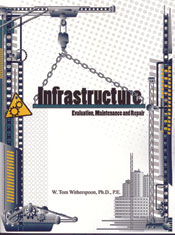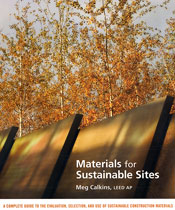
| Infrastructure Evaluation, Maintenance and Repair By W. Tom Witherspoon With President-elect Barack Obama’s plans in the works for an Eisenhower-style stimulus package designed to fix the nation’s roads, bridges and railways—and giving a sick economy a shot in the arm at the same time—a handy book has arrived to help public agencies, civil engineers and contractors take care of the patient. Year after year, the pleadings of various engineering organizations in Washington usually end with the same conclusion: We are in a state of general disrepair, and hundreds of billions of dollars are needed just to achieve a passing grade. All too often, though, politicians spend too much time pushing high-profile, pork-laden projects like new highway extensions to spur local economies that don’t yet exist. Meanwhile, existing roads, sewers and bridges continue to crumble away and add stress to already-developed communities. There is no doubt that much more work needs to be done to right these spending imbalances, but it ultimately is in the hands of federal, state and local legislators to muster the will to attack the problem so the construction industry can do its job. The will may have finally arrived, so now what? Author W. Tom Witherspoon does not spend a lot of time pointing to the broken politics. He gets down to business quickly and serves as a field guide to common problems on highways, bridges, airports, buildings and parking garages, emphasizing that “we sometimes must be as ingenious in their maintenance as we were in their construction.” President of Richardson, Texas-based S&W Foundation Contractors, Witherspoon is a seasoned structural repairman specializing in rescuing structures mired in expansive soil. His crews are used to drilling in dark, dirty crawl spaces to solve problems that lurk deep beneath the surface. So it is no surprise that Witherspoon’s down-to-earth style becomes the perfect underpinning for the mundane topic of fixing things that most people take for granted. This easiness also is at times a turn-off, because the book skims past nonbuilding repairs. Sewers, levees and other important structures also lack treatment. It is clear from the start that this author had his hands full covering just buildings. Still, a lot of ground is covered in 354 pages, with a good amount of technical detail. Each chapter introduces a new structure, then moves on to best practices for prioritizing and executing repairs. Black-and-white photos and illustrations complement this “owner’s manual” to the world around us. |

| Materials for Sustainable Sites By Meg Calkins This book is intended to be the complete guide to the evaluation, selection and use of sustainable materials as part of the growing strategy to minimize environmental and human health impacts of conventional and green building materials. It is written for all professionals who design, specify, or regulate sustainable sites, as well those who educate practioners. Materials covered include concrete, earthen materials, brick masonry, asphalt pavement, biobased materials, aggregates and stone, wood and wood products, metals, plastics and rubber. “Environmental and human-health impacts of materials are a hidden cost of our built environment,” says author Meg Calkins. “Impacts during manufacture, transport, installation, use and disposal of construction materials can be significant, yet often invisible” because the manufacturing and disposal is often remote from the jobsite, she says. Life-cycle assessments of materials impact are difficult and make comparisons of materials complex, “and the right answer may not always lie in a new green material, but instead in a conventional tried-and-true material used in green ways,” she explains. The first four chapters discuss general environmental and human-health issues and provide tools, techniques, ideologies and resources for evaluating, sourcing and specifying sustainable materials. The second part of the book examines nine materials and provides strategies to minimize their impact on the environment and humans. According to the author, the book emphasizes four principles:
|

Post a comment to this article
Report Abusive Comment